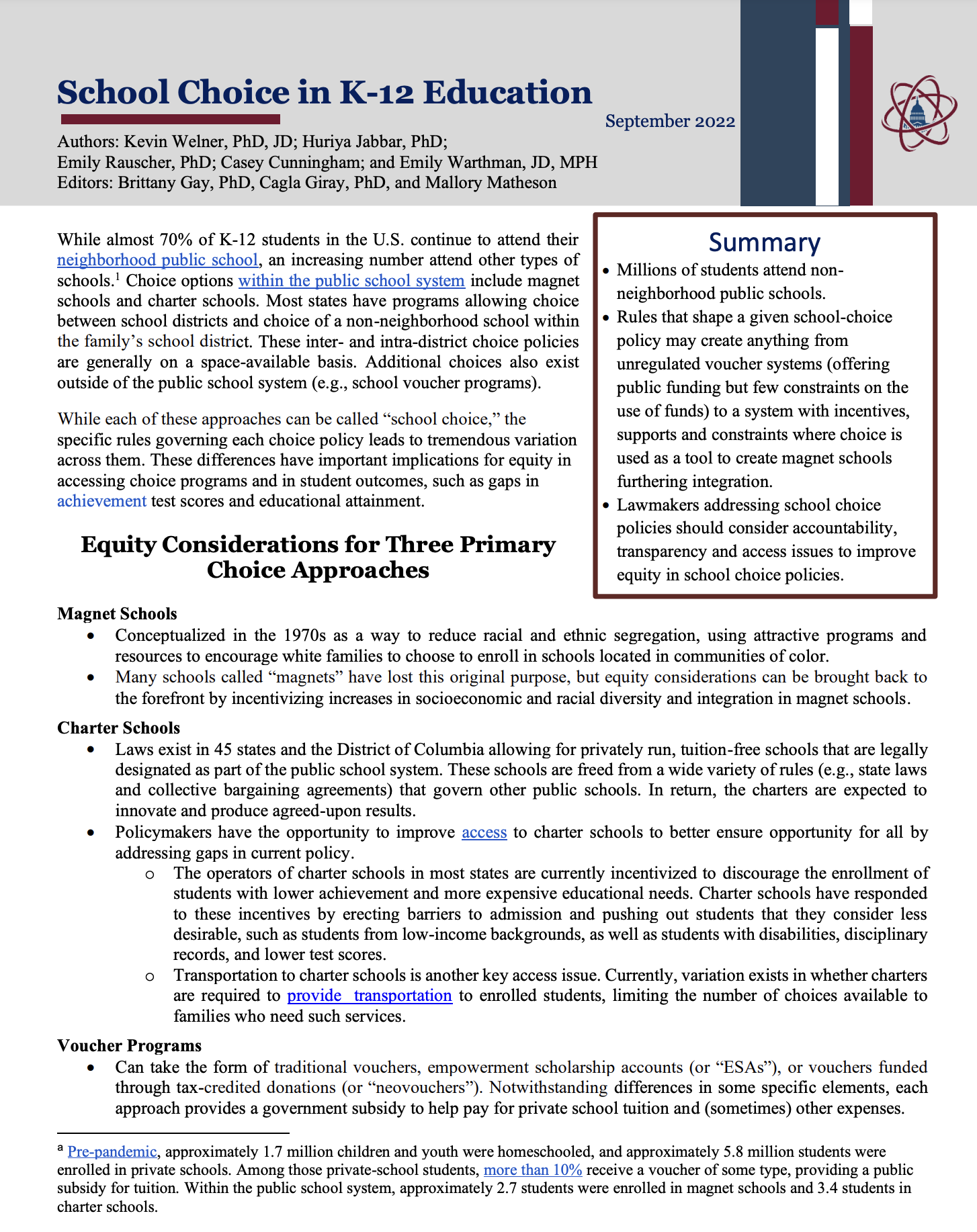
While almost 70% of K-12 students in the U.S. continue to attend their neighborhood public school, an increasing number attend other types of schools.[a] Choice options within the public school system include magnet schools and charter schools. Most states have programs allowing choice between school districts and choice of a non-neighborhood school within the family’s school district. These inter- and intra-district choice policies are generally on a space-available basis.
While each of these approaches can be called “school choice,” the specific rules governing each choice policy leads to tremendous variation across them. These differences have important implications for equity in accessing choice programs and in student outcomes, such as gaps in achievement test scores and educational attainment.
Summary
- Millions of students attend non-neighborhood public schools.
- Rules that shape a given school-choice policy may create anything from unregulated voucher systems (offering public funding but few constraints on the use of funds) to a system with incentives, supports and constraints where choice is used as a tool to create magnet schools furthering integration.
- Lawmakers addressing school choice policies should consider accountability, transparency and access issues to improve equity in school choice policies.
Equity Considerations For Three Primary Choice Approaches
Magnet Schools
- Conceptualized in the 1970s as a way to reduce racial and ethnic segregation, using attractive programs and resources to encourage white families to choose to enroll in schools located in communities of color.
- Many schools called “magnets” have lost this original purpose, but equity considerations can be brought back to the forefront by incentivizing increases in socioeconomic and racial diversity and integration in magnet schools.
Chapter Schools
- Laws exist in 45 states and the District of Columbia allowing for privately run, tuition-free schools that are legally designated as part of the public school system. These schools are freed from a wide variety of rules (e.g., state laws and collective bargaining agreements) that govern other public schools. In return, the charters are expected to innovate and produce agreed-upon results.
- Policymakers have the opportunity to improve access to charter schools to better ensure opportunity for all by addressing gaps in current policy.
- The operators of charter schools in most states are currently incentivized to discourage the enrollment of students with lower achievement and more expensive educational needs. Charter schools have responded to these incentives by erecting barriers to admission and pushing out students that they consider less desirable, such as students from low-income backgrounds, as well as students with disabilities, disciplinary records, and lower test scores.
- Transportation to charter schools is another key access issue. Currently, variation exists in whether charters are required to provide transportation to enrolled students, limiting the number of choices available to families who need such services.
Voucher Programs
- Can take the form of traditional vouchers, empowerment scholarship accounts (or “ESAs”), or vouchers funded through tax-credited donations (or “neovouchers”). Notwithstanding differences, each approach provides a government subsidy to help pay for private school tuition and (sometimes) other expenses.
- Strategies for increasing equity in the voucher system:
- Requiring anti-discrimination commitments as a condition of receiving public funding, as well as commitments to serve students with special needs and protections for these students akin to those provided in public schools.
- Inclusion of quality controls into voucher program requirements. The need for such controls is exemplified by recent evidence of strong negative effects of participating in voucher programs on student achievement, such that students who received vouchers to attend private school performed worse (particularly in math) than comparison students without the vouchers.
- Means-testing applicants can also help ensure public subsidies are targeted towards those with a financial need (as opposed to is helping wealthy families with a portion of the tuition they would have privately paid).
End Notes / References
a. Pre-pandemic, approximately 1.7 million children and youth were homeschooled, and approximately 5.8 million students were enrolled in private schools. Among those private-school students, more than 10% receive a voucher of some type, providing a public subsidy for tuition. Within the public school system, approximately 2.7 million students were enrolled in magnet schools and 3.4 million students in charter schools.
The Research-to-Policy Collaboration (RPC) works to bring together research professionals and public officials to support evidence-based policy. Please visit their website to learn more.
Key Information
RPC Website
Research-to-Policy Collaboration
Publication DateSeptember 22, 2022
Topic Area(s)Education and Child Development, Equity
Resource TypeWritten Briefs
Share This Page
While almost 70% of K-12 students in the U.S. continue to attend their neighborhood public school, an increasing number attend other types of schools.[a] Choice options within the public school system include magnet schools and charter schools. Most states have programs allowing choice between school districts and choice of a non-neighborhood school within the family’s school district. These inter- and intra-district choice policies are generally on a space-available basis.
While each of these approaches can be called “school choice,” the specific rules governing each choice policy leads to tremendous variation across them. These differences have important implications for equity in accessing choice programs and in student outcomes, such as gaps in achievement test scores and educational attainment.
Summary
- Millions of students attend non-neighborhood public schools.
- Rules that shape a given school-choice policy may create anything from unregulated voucher systems (offering public funding but few constraints on the use of funds) to a system with incentives, supports and constraints where choice is used as a tool to create magnet schools furthering integration.
- Lawmakers addressing school choice policies should consider accountability, transparency and access issues to improve equity in school choice policies.
Equity Considerations For Three Primary Choice Approaches
Magnet Schools
- Conceptualized in the 1970s as a way to reduce racial and ethnic segregation, using attractive programs and resources to encourage white families to choose to enroll in schools located in communities of color.
- Many schools called “magnets” have lost this original purpose, but equity considerations can be brought back to the forefront by incentivizing increases in socioeconomic and racial diversity and integration in magnet schools.
Chapter Schools
- Laws exist in 45 states and the District of Columbia allowing for privately run, tuition-free schools that are legally designated as part of the public school system. These schools are freed from a wide variety of rules (e.g., state laws and collective bargaining agreements) that govern other public schools. In return, the charters are expected to innovate and produce agreed-upon results.
- Policymakers have the opportunity to improve access to charter schools to better ensure opportunity for all by addressing gaps in current policy.
- The operators of charter schools in most states are currently incentivized to discourage the enrollment of students with lower achievement and more expensive educational needs. Charter schools have responded to these incentives by erecting barriers to admission and pushing out students that they consider less desirable, such as students from low-income backgrounds, as well as students with disabilities, disciplinary records, and lower test scores.
- Transportation to charter schools is another key access issue. Currently, variation exists in whether charters are required to provide transportation to enrolled students, limiting the number of choices available to families who need such services.
Voucher Programs
- Can take the form of traditional vouchers, empowerment scholarship accounts (or “ESAs”), or vouchers funded through tax-credited donations (or “neovouchers”). Notwithstanding differences, each approach provides a government subsidy to help pay for private school tuition and (sometimes) other expenses.
- Strategies for increasing equity in the voucher system:
- Requiring anti-discrimination commitments as a condition of receiving public funding, as well as commitments to serve students with special needs and protections for these students akin to those provided in public schools.
- Inclusion of quality controls into voucher program requirements. The need for such controls is exemplified by recent evidence of strong negative effects of participating in voucher programs on student achievement, such that students who received vouchers to attend private school performed worse (particularly in math) than comparison students without the vouchers.
- Means-testing applicants can also help ensure public subsidies are targeted towards those with a financial need (as opposed to is helping wealthy families with a portion of the tuition they would have privately paid).
End Notes / References
a. Pre-pandemic, approximately 1.7 million children and youth were homeschooled, and approximately 5.8 million students were enrolled in private schools. Among those private-school students, more than 10% receive a voucher of some type, providing a public subsidy for tuition. Within the public school system, approximately 2.7 million students were enrolled in magnet schools and 3.4 million students in charter schools.
The Research-to-Policy Collaboration (RPC) works to bring together research professionals and public officials to support evidence-based policy. Please visit their website to learn more.

Key Information
RPC Website
Research-to-Policy Collaboration
Publication DateSeptember 22, 2022
Topic Area(s)Education and Child Development, Equity
Resource TypeWritten Briefs
Share This Page
LET’S STAY IN TOUCH
Join the Evidence-to-Impact Mailing List
Keep up to date with the latest resources, events, and news from the EIC.




